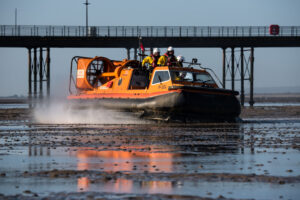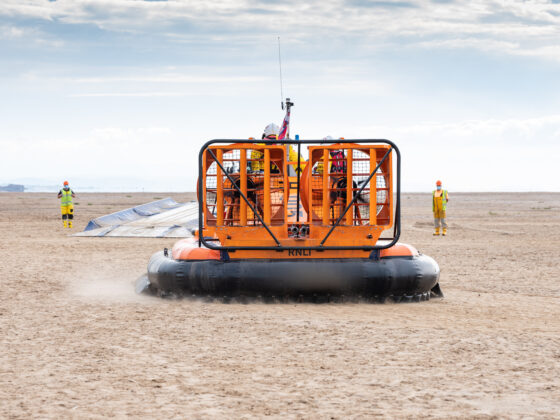
RNLI celebrates 20th anniversary of rescue hovercraft

The Royal National Lifeboat Institution (RNLI) is celebrating 20 years of saving lives at sea with its inshore rescue hovercraft (IRH).
Introduced in 2002, the amphibious inshore rescue hovercraft enables the RNLI to carry out its lifesaving work in areas inaccessible to conventional lifeboats. Designed for search and rescue purposes, the hovercraft can tackle incidents on tidal mudflats or sand where the surface is too soft to support land vehicles and where the water is too shallow for boats. Prior to 2002, the only method of rapid access to these areas was by helicopter or walking.
The RNLI currently operates seven IRH out of four stations (Morecambe, Hunstanton, Southend-on-Sea and Hoylake), with three part of its relief fleet. Since joining its fleet two decades ago, the charity says the hovercraft has extended its lifesaving capability around the coast, aiding over 1,200 people and saving 78 lives.
“For the last 20 years, the hovercraft has enabled us to carry out rescues in sheltered, shallow waters where our other boats cannot operate and in specific limited weather conditions,” says Jamie Chesnutt, RNLI director of engineering and supply. “It’s ability to reach 30 knots makes it fast and manoeuvrable, allowing quick access to these hard-to-reach areas, as well as making it useful for assisting with shoreline searches.
“It’s unique features and capabilities including its versatility and speed has made a huge difference to the efficiency and effectiveness of our 24/7 search and rescue service. We are working on plans for the next generation of hovercraft to continue enabling our crews to save lives at sea around the UK.”

Hunstanton RNLI’s hovercraft, H-003 Hunstanton Flyer, out on a training exercise in 2019. Image credit: RNLI/Nigel Millard
In the past two decades, the hovercraft has launched a total of 1,466 times*, with 34 of those shouts involving animal rescues, including horses, dogs and even dolphins.
“In 2020, we were tasked to rescue two dolphins near London Gateway Port, where they got stranded from the shore at Mucking Flats. It was a multi-agency rescue involving Essex Fire and Rescue and the British Divers Marine Life Rescue,” says David Cartwright, hovercraft commander at Southend-on-Sea RNLI.
“The dolphins had managed to create a hollow in the mud and were unable to get back to the water. Using two inflatable rafts, one on each side of the hovercraft, we ferried the two dolphins back to the open water across the mudflats.
“It was a surreal experience having two dolphins strapped to either side of the hovercraft whilst flying it. It was an unusual but memorable day.”
The IRH is equipped with specialised mud-rescue equipment, a spinal board and a First Aid kit so RNLI volunteers are always prepared for any type of rescue. Giving an overall height of 2.25 metres when inflated, the hovercraft has two inflatable sponsons which are used to provide stability and additional buoyancy and offer a soft edge for casualty recovery.
With large areas of mud, sand and shallow water, Morecambe, Hunstanton, Southend-on-Sea and Hoylake Lifeboat Stations require the hovercraft for its unique capabilities in reaching inaccessible areas, shoreline searches, and tackling dangerous terrain
“The hovercraft has become a real, and significant, asset to the station and the RNLI overall,” explains hovercraft commander at Hoylake RNLI, James Whiteley. “It is a very specific craft designed to tackle different terrain and there has been many occasions that without the hovercraft, some people wouldn’t be alive today.”

Hoylake RNLI’s hovercraft, H-005 Hurley Spirit, returning from a shout in 2021. Image credit: RNLI/David Edwards
*Statistic combines launches from all four hovercraft stations: Morecambe, Hunstanton, Southend-on-Sea and Hoylake.
